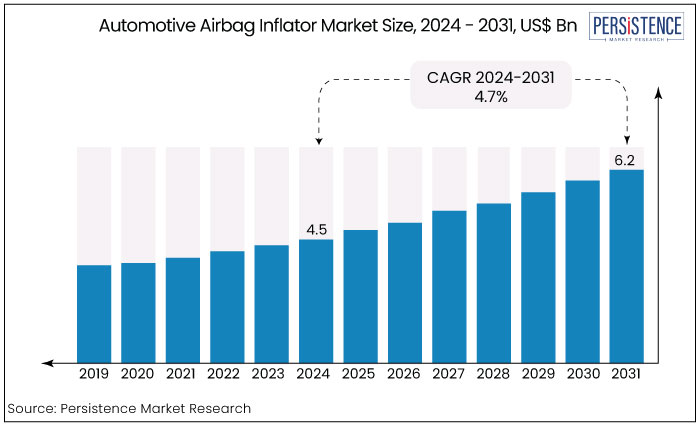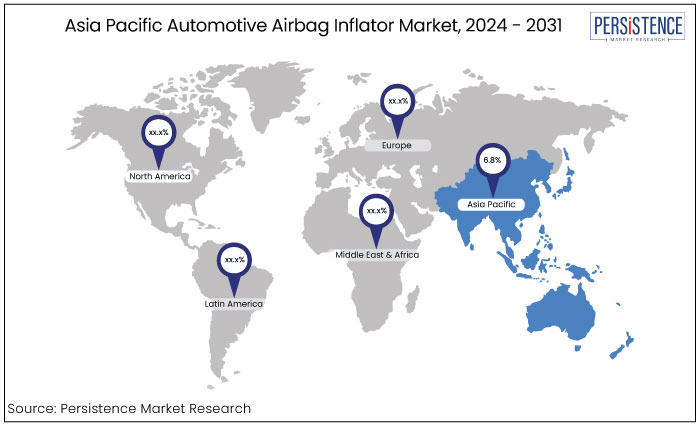Automotive Airbag Inflator Market
Industry: Automotive & Transportation
Published Date: November-2024
Format: PPT*, PDF, EXCEL
Delivery Timelines: Contact Sales
Number of Pages: 184
Report ID: PMRREP34902
The global automotive airbag inflator market is projected to witness a CAGR of 4.7% during the forecast period from 2024 to 2031. It is anticipated to increase from US$ 4.5 Bn recorded in 2024 to a staggering US$ 6.2 Bn by 2031.
The global tightening of safety regulations is driving demand for automotive airbag inflators. Government agencies are enforcing strict standards to reduce road accidents and injuries. Several countries now require all new cars to have airbags. This has pushed automakers to adopt highly advanced airbag systems, driving the market.
Initiatives by governments across various countries play a key role in awareness and industry expansion. For example, the National Highway Traffic Safety Administration’s (NHTSA) handling of the Takata airbag recalls, affecting about 67 million airbags in millions of vehicles, has raised awareness of the dangers of defective inflators. This massive recall has led to increased public awareness on vehicle safety and the importance of addressing recalls promptly.

Key Highlights of the Market
|
Market Attributes |
Key Insights |
|
Market Size (2024E) |
US$ 4.5 Bn |
|
Projected Market Value (2031F) |
US$ 6.2 Bn |
|
Global Market Growth Rate (CAGR 2024 to 2031) |
4.7% |
|
Historical Market Growth Rate (CAGR 2019 to 2023) |
4.1% |
|
Region |
CAGR through 2031 |
|
Asia Pacific |
6.8% |
Asia Pacific is projected to experience a CAGR of around 6.8% in the automotive airbag inflator industry during the forecast period from 2024 to 2031. Rising public awareness from media campaigns about road safety is a key factor driving growth in the region. For example,
Launch of similar campaigns are set to help raise awareness about road safety issues and promote safe driving practices. People are becoming highly conscious of the importance of vehicle safety, which is leading to increased demand for airbag inflators. Additionally, growing interest in autonomous vehicles is boosting the market. These vehicles often come equipped with unique safety features, including sophisticated airbag systems.

|
Region |
CAGR through 2031 |
|
North America |
4.2% |
North America is expected to witness steady expansion at a CAGR of about 4.2% from 2024 to 2031. This growth is set to be driven by government initiatives aimed at improving vehicle safety. Also, ongoing product innovations that enhance airbag technologies are anticipated to boost demand. For example,
Extensive research and development activities are helping to bring new and improved inflator designs to market. These combined efforts are positioning North America as a strong player in the automotive airbag inflator landscape.
|
Category |
CAGR through 2031 |
|
Product Type- Pyrotechnic Inflator |
7.9% |
Based on product type, the pyrotechnic inflator segment is anticipated to lead the global market through 2031. This type of inflator is widely used due to its effectiveness in rapidly deploying airbags during collisions.
The pyrotechnic inflator segment is projected to rise at a CAGR of about 7.9% from 2024 to 2031. It reflects ongoing advancements in safety technology and increasing demand for enhanced vehicle safety features. The dominance of these inflators can also be attributed to their widespread use and effectiveness in automotive safety systems. They are designed to deploy airbags rapidly during a collision, providing crucial protection to vehicle occupants.
The technology behind pyrotechnic inflators has been well developed, and ongoing advancements continue to enhance their reliability and performance. A wide range of companies are using pyrotechnic inflators to increase safety.
|
Category |
CAGR through 2031 |
|
Vehicle Type - Passenger Vehicle |
4.2% |
Based on vehicle type, passenger vehicles are projected to exhibit significant growth at a CAGR of 4.2% from 2024 to 2031. It can be attributed to the critical importance of safety features in these vehicles.
Airbag inflators are essential for protecting occupants during collisions. Modern passenger cars are equipped with multiple airbags, including front, side, curtain, and knee airbags. Each of these requires reliable and efficient inflators to ensure they deploy promptly in the event of an accident. For example,
Increasing demand for advanced airbag inflators in passenger vehicles is set to be fueled by stringent safety regulations and a growing consumer awareness of vehicle safety.
As urban areas broaden and incomes rise, more people are looking for passenger cars, self-driving vehicles, and luxury options, which is boosting the market for airbag inflators. Additionally, the popularity of ride-sharing services is pushing the need for high safety standards in vehicles, including the use of airbag inflators. For instance,
There is also an increase in lawsuits against car manufacturers for not providing enough safety features, leading to more cars being equipped with multiple airbags. Growing focus on keeping drivers and passengers safe, especially with rising cases of serious road accidents, is contributing to market growth. Commercial vehicles like delivery vans, buses, and trucks are also being fitted with inflators to protect occupants in case of an accident, which is boosting demand.
The global market witnessed a CAGR of 4.1% in the historical period between 2019 and 2023. Driver safety was a key concern for high-performance and luxury vehicles. As the number of accidents surged, several vehicle manufacturers started developing cars equipped with new safety features. For instance,
Safety features in the early days focused on aspects like strong vehicle bodies and effective braking systems. However, as consumer safety has gained more attention, the emphasis has shifted to enhancing both vehicle performance and passenger protection. This led to the development of various airbag types to safeguard all occupants, not just the driver.
The market is further anticipated to be pushed by increased consumer awareness of safety, a competitive buyer-centric market, and automakers' commitment to brand image and passenger well-being. The global market is projected to rise at a CAGR of around 4.7% from 2024 to 2031.
Strict Government Norms Supporting Public Safety to Bolster Demand
A key reason for the growing demand for automotive airbag inflators is the tightening of safety regulations globally. Government agencies are stepping up their efforts to enforce strict vehicle safety standards aimed at reducing road accidents and injuries. Various countries now require that all new cars come equipped with airbags, which is a clear response to data showing that airbags significantly lower the risk of severe injuries in accidents. For example,
As a result of the aforementioned safety requirements, car manufacturers are being pushed to adopt advanced airbag systems, which is driving the market for airbag inflators.
Media Coverage of Vehicle Safety Tests to Augment Demand
As people become more aware of road safety, they are paying close attention to the safety features in their vehicles. Social media campaigns, consumer reviews, and increased media coverage of vehicle safety tests have helped educate buyers about the key role of airbags.
In emerging countries where prices are a key consideration when buying a car, consumers are willing to spend a bit more on vehicles that come with advanced safety features like effective airbag inflators. This rising demand is set to have a direct positive effect on the growth of the new energy vehicle airbag inflator market. Various companies in the industry are focusing on developing effective and safe airbags for enhanced safety. For example,
Rising Safety Concerns and Product Recalls May Hamper Demand
A key challenge facing the global automotive airbag inflator market is the issue of safety concerns and product recalls. High-profile cases involving defective airbag inflators have led to rising scrutiny from consumers, regulatory bodies, and the auto industry. These safety recalls can severely damage a manufacturer’s reputation and come with significant costs for fixing and replacing faulty parts. For example,
Limited Public Awareness about Airbag Technology to Hinder Growth
Addressing changing consumer preferences and educating people about airbag technology is a key challenge in the automotive airbag inflator market. While awareness of vehicle safety is on the rise, consumers often have different levels of understanding when it comes to the details of airbag systems and their components, such as inflators. This lack of knowledge or misconceptions can affect consumer confidence and influence their buying choices.
Manufacturers need to effectively communicate the safety benefits, reliability, and advancements in airbag inflator technology to consumers. Government bodies in several countries are prioritizing public awareness and education for airbag inflators. For example,
Emergence of Smart Airbag Systems to Open the Door to Success
Technological innovations in the automotive industry, especially in the field of airbag systems, are significantly boosting the global automotive airbag inflator industry. Introduction of smart airbag systems marks a key step forward, as these inflators are equipped with sensors and algorithms that adjust deployment based on various factors. These factors can include the severity of a collision, the position of occupants, and other dynamic aspects, allowing for more accurate and effective airbag deployment.
Smart airbag systems improve safety and help reduce the risk of injuries related to airbags by optimizing how they deploy. As technology continues to progress, manufacturers are investing in research to make airbag inflators even smarter and more responsive. This push for innovation creates a vibrant market environment, with ongoing developments aimed at enhancing the effectiveness of airbag systems in protecting vehicle occupants. For instance,
Launch of Lightweight and Unique Materials to Create Fresh Prospects
The automotive industry's ongoing emphasis on reducing weight and using unique materials is playing a key role in shaping the global automotive airbag inflation market. The push for better fuel efficiency and lightweight vehicles has prompted manufacturers to explore new materials for making inflators. While traditional inflators typically used steel, innovations in materials science have led to the development of lightweight yet strong alternatives like composites and advanced alloys.
By adopting lightweight materials, manufacturers can reduce the total weight of vehicles without sacrificing safety. This trend supports the automotive industry's objectives of enhancing fuel efficiency and minimizing environmental impact. As a result, makers of airbag inflators are incorporating innovative materials into their designs. They are creating new products that not only perform well in crash situations but also align with the goals of sustainable automotive engineering.
The global market is highly competitive in nature owing to the presence of several large- and small-scale companies. Most of the big brands are focusing on bringing innovative products to cater to varying needs of automakers.
Local players are aiming for high shares by either selling their in-house products on online platforms or participating in trade fairs to exhibit their offerings. The industry is estimated to witness the entry of multiple start-ups in the next ten years.
Recent Industry Developments
|
Attributes |
Details |
|
Forecast Period |
2024 to 2031 |
|
Historical Data Available for |
2019 to 2023 |
|
Market Analysis |
US$ Billion for Value |
|
Key Regions Covered |
|
|
Key Market Segments Covered |
|
|
Key Companies Profiled in the Report |
|
|
Report Coverage |
|
|
Customization and Pricing |
Available upon request |
By Product Type
By Component Type
By Vehicle Type
By Region
To know more about delivery timeline for this report Contact Sales

Yes, the market is set to reach US$ 6.2 Bn by 2031.
Pyrotechnic, hybrid, and stored gas are the three main types.
Asia Pacific is projected to rise at a CAGR of around 6.8% from 2024 to 2031.
Autoliv is considered the leading manufacturer worldwide.
ZF Friendrichshafen AG, Autoliv Inc, and Denso Corporation are the key companies operating in India.